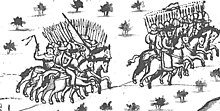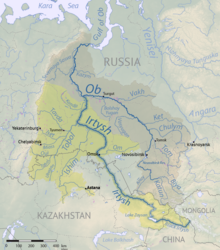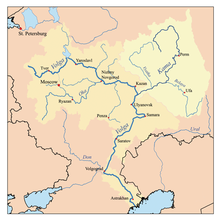Conquest of the Siberian Khanate

The conquest of the Siberian Khanate by Yermak in 1582 was a first step in the Russian conquest of Siberia . The Siberian Khanate was a state ruled by Muslim Tatars in the east of the central Ural Mountains .
The warring parties
Russia
The Novgorod Republic had developed into an empire shaped by the fur trade, stretching from northern Russia through the northern Urals and slightly beyond. The areas east of the empire gradually fell under the control of Moscow . The Kazan Khanate , which broke away from the Golden Horde around 1438, was located between Moscow and the Urals . Moscow conquered Novgorod in 1478 and Kazan in 1552. This opened up access to the area northeast of Kazan around the Kama River with the city of Perm , which borders the Ural Mountains . In 1558 the Stroganov family was given a large fiefdom in this area, which they began to develop. There was occasional local resistance to this. In 1573, the Siberian Khan sent his nephew to raid the Stroganov lands. Moscow responded with a legal document entitling the Stroganovs to wage a private war against the Khan.
The Siberian Khanate
The Ural Mountains represent a low mountain range that is relatively easy to negotiate along the width of the city of Perm . The area was populated by the Mansen tribe and, north of Tobolsk, by the Khanty tribe. The Siberian Khanate split off in the 15th century as a result of the decline of the Golden Horde . Two clans emerged who fought against each other for power: the Mongolian-born Scheibanids and the probably native Taibugids . In 1563 the Scheibanide Kütschüm Khan defeated his Taibugid rival and seized power. Before 1571, the khanate made limited tribute payments to Moscow.
The chronicles of Siberia are incomplete and inconsistent, as is the secondary literature in English. This article is based on the Lantzeff report, which appears to be the largest report in the English language.
The conquest of the khanate

Yermak Timofejewitsch is said to have originally been a river pirate on the Volga. Around 1577 these river pirates were driven out by the Russian authorities. Yermak went to Perm a short time later (probably 1579). It is doubtful whether he intended to conquer the khanate from the start. Rather, it seems that the expedition only culminated in a conquest after the khanate's weakness became apparent. It is also not clear whether Yermak carried out the operation of his own accord or was sent by the Stroganovs. Perhaps the stroganovs only encouraged him to get rid of the armed men who were perceived as dangerous. Yermak had the supreme command of 540 Cossacks, the Stroganovs provided most of the equipment and another 300 men (mainly prisoners of war).
Yermak probably left Perm in the summer of 1581 (according to Fisher he set out in September 1579 and took Sibir in October 1581; according to Lincoln, Yermak set out on September 1st and conquered Qashliq three months later). He sailed down the Chusovaya and built winter quarters in the mountains and launched attacks against the native Mansi. In spring he crossed the Ural Mountains to the Barancha River. He built wooden rafts with which he went down the river and which he later - when the river was deep enough - converted into boats. On the Tura , he finally sailed towards the southeast and defeated a local prince named Epancha at the place where Turinsk later emerged. Continuing the Tura he conquered Tyumen . Riverside Tobol the troops defeated an indigenous force, sailed further north and later won two more battles, just before the river Tavda flows into the Tobol. About 20 miles beyond the Tavda Estuary, they fought another battle and took possession of a local village where they are believed to have taken a month's break.
After leaving the camp they sailed to the mouth of the Tobol in the Irtysh at the height of today's Tobolsk . Qaschliq (= Sibir) was located twelve kilometers east of the Irtysh . The Russians took possession of the village of Atiq-Murza and used it as a base for a failed attack on Qashliq. A few days later they attacked again. The defenders' commander, Mamet-Kul (Kütschüm Khan's nephew), was wounded, causing disorder among the defenders. The chantic and mansic units dissolved. Kütschüm Khan was left with only his Tatar units, with which he fled his capital during the night so that the Russians could take possession of them the next morning. This probably happened in October 1582.
Taking possession
In the following months, a number of local princes submitted. Yermak found himself - perhaps unexpectedly - in the role of ruler. He sent Ivan Koltso to Moscow with 50 men and 5200 skins to publicize his conquest. In the meantime the Khanty and Mansi had invaded the Perm area again. Tsar Ivan the Terrible blamed Yermak for this and demanded that the Stroganovs return Yermak to protect Perm. A few days later, Yermak's messengers reached Moscow. After the tsar heard the story of the quick conquest, he changed his mind and promised to send a voivod with troops. He sent gifts to Yermak, including the famous armor.
The Cossacks sent units to collect tribute (mostly in the form of skins) from the local population. Bogdan Brjasga sailed to the area where the Irtysh flows into the Ob. Yermak himself explored the Tavda. Kütschüms whereabouts at this time is unknown. His nephew Mamet-Kul attacked the Russians several times and was eventually captured by them and taken to Moscow. Said Akhmat, Kütschüm's Taibugid opponent, returned to the area, where he was able to rally a number of supporters. Meanwhile the Karacha - the high nobility of the khanate - asked Jermak for help against the steppe nomads. On his return from Moscow, the messenger Ivan Koltso and his men were killed by locals who also managed to thwart the punitive expedition that followed. This seemed to have sparked a general uprising, making it unsafe to leave the fortress in Qashliq. In November 1584, 500 men came from Russia, including Strelizen . Food supplies became scarce and there were many deaths that winter. In March the Karacha besieged Qashliq, but the Russians managed to break the siege two months later (according to Naumov, they did so in March).
In August 1585, Jermak learned that Kütschüm wanted to plunder a trade caravan coming from the south. Yermak sailed upstream the Irtysh (south), but found neither Kütschum Khan nor the caravan. Once back, he encamped at the inflow of the Wagai -Flusses on, about 25 miles upriver from Tobolsk. The night was stormy and visibility was poor. Kütschüm's men managed to kill most of the Russians in their sleep. It is reported that Yermak drowned from the weight of the armor given by the Tsar while attempting to reach a getaway boat.
The loss of the khanate
Yermak's successor Ivan Gluchow sailed down Irtysh and Ob with 150 survivors. Despite further reinforcement under Mansurov, it was decided in the spring of 1586 to return to Russia. Kütschüm Khan's son Ali occupied Qaschliq, but was driven out again by Said Akhmat.
The reconquest
Yermak had been defeated, but the Siberian Khanate was down and Said Akhmat was no longer able to enforce the rule of the state. Power was now in the hands of armed locals. The Russians, for their part, began systematically building fortresses, a strategy that was already successful south of Moscow. In 1586 300 Russians built an ostrog near Tyumen and in 1587 near Tobolsk. In 1588 Said Akhmad and the Karacha were invited to Tobolsk, where they were captured and deported to Moscow. In 1594, Tara was founded on the Irtysh to protect the trade routes. In 1591 the Mansen settlement around the Konda River was annexed. Surgut near the mouth of the Irtysh in the Ob was founded in 1594. Also in 1594 the Prince of Pelym (in the area of the Pelym River ) was defeated. Kütschüm Khan, who continued to resist, was defeated in the Barabasteppe around 1598 . In 1598 Verkhoturye was built, which was supposed to secure the route across the Urals lying on the Tura. In the 1590s the Russians crossed the northern Urals into the lower Ob basin. In 1602, Ketsk was founded on the Ket River , which opened the way to the Yenisei River .


